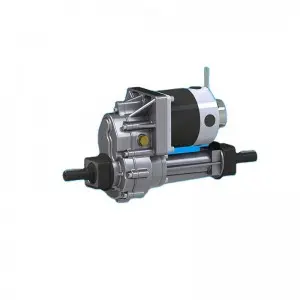The transaxle is an important part of a vehicle’s drivetrain, responsible for transmitting power from the engine to the wheels. It combines the functions of a gearbox and a differential that allows the wheels to rotate at different speeds. Like any mechanical system, the transaxle requires regular maintenance and occasional repairs to ensure optimal performance and longevity. In this article, we’ll explore the service your transaxle may need, including maintenance, troubleshooting, and repair.
Fluid inspection and replacement
One of the most important services your transaxle requires is regular fluid inspection and replacement. Transaxle oil lubricates the gears and bearings within the transaxle, helping to reduce friction and heat. Over time, the fluid can become contaminated with metal particles and other debris, causing increased wear and potential damage to the transaxle components. It is recommended that the transaxle fluid level and condition be checked regularly and replaced according to the manufacturer’s recommendations.
Inspection and adjustment of gears
The gears in the transaxle are subject to high levels of stress and wear during operation. Therefore, they may require periodic inspection and adjustment to ensure smooth and efficient operation. Worn or damaged gears can cause excessive noise, vibration, and even transmission slippage. A qualified technician can inspect the gears for signs of wear and make the necessary adjustments to maintain proper engagement and engagement.
Differentiated services
The differential is an integral part of the transaxle that allows the vehicle to rotate at different speeds when cornering. Differentiated services may include checking and changing gear oil, inspecting gears and bearings, and adjusting backlash and preload as needed. Proper differential maintenance is critical to ensuring stable and predictable handling, especially during cornering and maneuvering.
Axle and CV joint inspection
The transaxle is connected to the wheels via axles and constant velocity (CV) joints. These components are under a lot of stress and can wear out over time, causing rattling or popping sounds when turning, vibrations, and even loss of power transmission. Regular inspection of axles and constant velocity joints can help identify any signs of wear or damage so they can be replaced promptly and prevent more extensive damage to the transaxle.
Replacement of seals and gaskets
The transaxle contains various seals and gaskets to prevent fluid leakage and contamination. Over time, these seals and gaskets can become brittle and leak, causing fluid loss and potential damage to the transaxle components. Replacing seals and gaskets at the first sign of leakage can help prevent more extensive damage and ensure proper transaxle operation.
Transmission oil flushing
In addition to transaxle oil, transmission oil also plays a vital role in the operation of the transaxle. A transmission fluid flush can help remove any accumulated contaminants and debris, ensuring proper lubrication and cooling of transmission components. This service is especially important if the vehicle is exposed to harsh driving conditions, such as towing or stop-and-go traffic.
Electronic diagnostics
Modern transaxles are equipped with an electronic control unit (ECU) that monitors and controls all aspects of transmission operation. When a transaxle-related problem arises, electronic diagnostics can help determine the root cause of the problem, whether it’s a faulty sensor, a faulty solenoid or an internal mechanical issue. Technicians can use specialized diagnostic tools to retrieve error codes and perform functional tests to pinpoint the source of the problem.
Clutch adjustment or replacement
For vehicles with a manual transmission, the clutch is an integral part of the transaxle system. Over time, clutches may wear out and require adjustment or replacement. Symptoms of clutch wear include slipping, difficulty shifting, and a spongy or vibrating clutch pedal. Properly adjusting or replacing the clutch can restore smooth and precise operation of the transaxle.
Overhaul or rebuild
If the transaxle is severely damaged or worn, it may require major repairs or rebuilding to return the transaxle to normal operating condition. This process involves removing the transaxle, inspecting all components for wear and damage, and replacing any worn or damaged parts. Thoroughly cleaning and reassembling the transaxle, with proper adjustments and fluid refills, can extend the life of the transaxle and ensure reliable performance.
Performance upgrade
For enthusiasts looking to improve their vehicle’s performance, there are various aftermarket upgrade options for the transaxle system. These upgrades may include performance gear sets, limited-slip differentials and enhanced components to handle the increased power and torque. Properly installed and adjusted, these upgrades can significantly improve the driving experience and durability of your transaxle.
In summary, the transaxle is a critical component of your vehicle’s drivetrain and requires regular maintenance and occasional repairs to ensure optimal performance and longevity. By following the manufacturer’s recommended maintenance schedule and promptly treating any signs of wear or damage, vehicle owners can enjoy smooth, reliable operation of their transaxle. Whether it’s a fluid check and change, gear inspection and adjustment, differential repair or a more extensive repair, proper care and attention to your transaxle can help extend its life and maintain your vehicle’s overall performance.
Post time: Sep-11-2024


